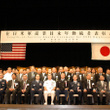Continued care hard to find for Haitian patients discharged from USNS Comfort

View Gallery (3 images)
ABOARD USNS COMFORT — Before this American hospital ship could even be seen off the coast of earthquake-devastated Port-au-Prince last month, Haitians with desperate crush injuries were flown out to the ship for emergency surgery. But bringing patients aboard has proven much easier than sending them home.
Of the roughly 400 patients on the Comfort, around 150 are ready to be discharged to a less sophisticated facility, if only they had some place to go.
The U.S. military, the United Nations and other aid groups are building an interim care facility with at least 150 beds in Port-au-Prince to serve as a central discharge center, but it’s not a reality yet.
“The main question now is: What Haitian facility ashore can take them?” said Cmdr. Tim Donahue, director of surgery on the Comfort.
The answer would be simpler if it were only a matter of discharging patients, but most of them need to be transferred for continued treatment. Their injuries are so severe they require significant follow-up care, in some cases for up to a year.
Many of the existing Haitian hospitals and clinics simply can’t provide the level of care needed. Even those patients who no longer require surgery often still have major wounds that need complicated dressing daily in a sterile environment. And it’s common for clinics to require the patients be able to stand on their own for certain amount of time to be able to feed themselves and go to the bathroom.
Some patients have been aboard since the Comfort arrived. It took a week before the crew was able to even start the process of discharging patients because communications ashore were so limited, according to Lt. Cmdr. Dan O’Aurora, who is in charge of casualty receiving.
The first responders, such as the Israelis and Belgians, have already left, eliminating potential places to send patients.
Getting patients off the ship has been an evolving process as Haiti’s infrastructure recovers, Donahue said.
“We have to figure it out on the fly in a country we don’t know,” said Capt. Andy Johnson, director of medical operations.
The Comfort is starting to build a network of potential destinations for patients — keeping track of what the facilities can do, how far away they are and how many patients they can take. But getting them there is a challenge, Johnson said.
Basic logistics issues have slowed the process. For example, some patients simply can’t travel by car because of the extent of their injuries, but some hospitals don’t have anywhere for helicopters to land. The military first had to make a landing zone before being able to use those hospitals, Johnson said.
To match the injured to the right facility ashore, the crew has created a detailed list of patients and their needs. Officials at the shore-based facilities then select which patients they can treat.
It hasn’t always gone smoothly. One clinic said they could take 30 patients a day but it has since run out of supplies.
“Now I wonder about the patients we sent them the day before,” Donahue said.
The Navy is refining the system. The Comfort sent people ashore last week to figure out what the facilities can really handle.
“We want to make certain the patients go somewhere that has the ability to care for them,” Donahue said. “There’s no lack of good intentions, but we have to ensure they actually have the resources.”
Particularly problematic are the orphaned children. There are at least a dozen being treated on the Comfort who don’t have any living family. Johnson said the crew has been working with UNICEF to place the children in approved orphanages.
The ultimate goal is to keep as many patients in Haiti as possible, but some have such severe breaks and soft-tissue damage that they need the aggressive care of the United States health care system.
And there are the many patients who need skin grafts, such as 16-year-old girl who lost all of the skin around her shin bone.
“You need a very clean place for that,” Donahue said. “And even here they’re going to go next to a dirty patient right next door.”
The longer the Comfort is docked outside Haiti, the more complicated the discharge process becomes.
The ship is now taking patients whose problems aren’t earthquake related but who simply need trauma care unavailable in Haiti.
The big question is when does the ship stop taking patients.
“We’re trying to define: What’s our role? What’s our mission?” Donahue said. “Haiti needs a big hospital. Are we going to be that?”
The questions are complicated by the vast difference in quality of care between American and Haitian medicine.
Before the hospital ship arrived, the Haitian government asked the doctors onboard to keep in my mind that Haiti would not be able to provide the same kind of after-care support that is available in the United States. In the case of severe neurological injury, for example, the government did not want the doctors to go to heroic measures to save a life.
“They said: ‘Apply a standard we can take care of when you leave,’” Donahue said.
This posed some ethical dilemmas for the doctors.
For many of those who came in with severe burns — cooking with oil over open flames is common in Haiti — the Comfort crew simply gave them supportive care until they died.
“The reality is they were not going to survive in Haiti,” Donahue said.
Not all burn injuries were a death sentence. At least 12 such cases were medevaced to the United States.
Another example that poses problems are patients with broken necks and backs. There were a lot of those injuries because as children Haitians are taught to stand against a wall during an earthquake, and the crashing buildings crushed their spines.
“What do we do with them, because they are not going to get better,” Donahue said. “What are the health care support systems in Haiti for a quadriplegic?”
Those who are able to be discharged back to Haiti leave the ship by boat or helicopter. They go with clear plastic bags of personal belongings and A few apples and a bottle of water tucked in with their blankets.
The Comfort doctors say they struggle with not being able to see them through all the way to recovery.
“You always have concerns because you’re not able to close the loop yourself,” said Cmdr. William Todd, an orthopedic surgeon. “We’re here doing the right thing and you hope that fate takes care of the rest.”










